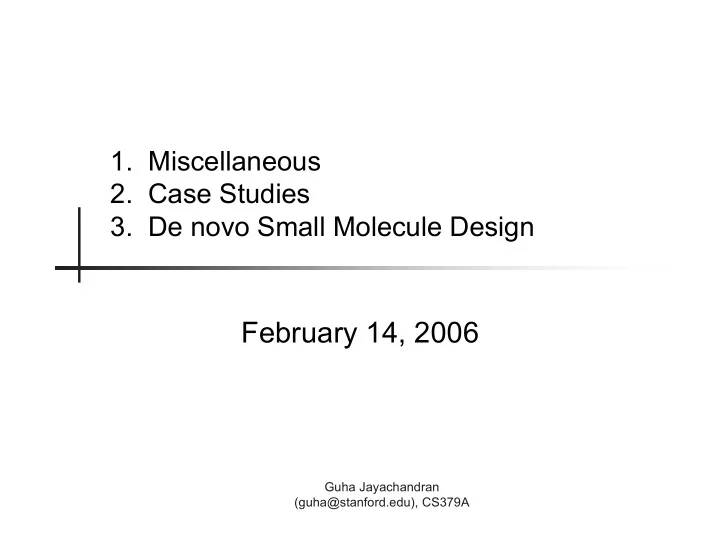

1. Miscellaneous 2. Case Studies 3. De novo Small Molecule Design February 14, 2006 Guha Jayachandran (guha@stanford.edu), CS379A
Pareto Optimality From Schneider and Fechner (NRD 2005)
Case Studies n Topic n Anything related to computational drug discovery (protease docking, example of focused libraries construction, new grid architectures, etc.) n Journal article fine. If white paper or something like that, just check with me. n Emphasize applications over methods n If you want to do something different (like research proposal), let me know n Present what was done, what techniques were used, and what you think n Quick: 5 minute presentation (March 14) n More detailed: ~1 page written (due by March 23)
De novo Small Molecule Design Guha Jayachandran (guha@stanford.edu), CS379A
Paradigms n Luck n Go out, collect samples, see if anything works n Asprin and penicillin examples n Screening Penicillin n Experimental vs. virtual n Various computational techniques n Can’t screen everything n Design
Uses of Design n Goal n Ligand that binds to receptor and can be synthesized (synthetic accessibility has been a big challenge) n Maybe other goals like ADME (so multidimensional optimization) n Motivation n Lead generation for screening n Novel compounds and scaffold hopping n Give new ideas to chemists
Choices n Information input n Receptor based (need structure of receptor) or ligand based (use known ligands) n Scoring function n Force field, knowledge based, empirical, similarity n Structure assembly method n Structure search algorithm
Example Construction Methods From Schneider and Fechner (NRD 2005)
TOPAS Remaking Imanitib Substitute fragments (so synthetically accessible) 50 generations to Gleevec From Schneider and Fechner (NRD 2005)
Synthetic Accessibility n Has been big problem in de novo design n A virtually ligand isn’t very useful if it can’t be made real n One approach: build in what reactions are possible n Use parts of known ligands (like in BREED)
Example Programs
Readings Combinatorial computational method gives new picomolar ligands for a n known enzyme (Grzybowski, et. al.) BREED: Generating Novel Inhibitors through Hybridization of Known n Ligands. Application to CDK2, P38, and HIV Protease (Pierce, Road, and Bemis) CONCERTS: Dynamic Connection of Fragments as an Approach to de n Novo Ligand Design (Pearlman and Murcko) A genetic algorithm for structure-based de novo design (Pegg, Haresco, n and Kuntz)
Recommend
More recommend